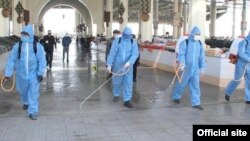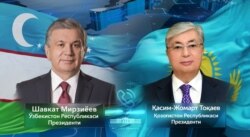In February, when COVID-19 began to explode beyond Wuhan and into China’s eastern and southern neighbors, the countries across China’s western frontier curiously claimed to be unaffected. South Korea, Japan, and Singapore struggled to manage and mitigate new infections, yet governments in Central Asia insisted that all was normal.
But by mid-March, they were compelled by sheer numbers to report cases. Kazakhstan, Kyrgyzstan, and Uzbekistan have seen a wave of infections. And they have become proactive in taking measures to halt its spread.
As of April 10, Kyrgyzstan, the region’s freest society, reported 298 infections, with 802 in Kazakhstan, and 624 in Uzbekistan. The three have reported only 17 deaths in total. Two countries lag: Tajikistan and Turkmenistan have lived up to their reputations as two of the world’s most closed political systems by clinging to the fantastical claim of zero cases.
Pandemics inevitably affect everyone, old and young, urban and rural, powerful and powerless. So, the region’s leaders have had to speak up.
“This is a virus that came from abroad, but we will overcome it,” says Shavkat Mirziyoyev, the Uzbek president, who has addressed his nation weekly since acknowledging the outbreak.
“The state will and is doing everything it can … but people have to do their part. Those quarantined must follow the rules or else face severe punishment. Everyone else, stay home, protect yourself,” Mirziyoyev said on April 3 in Tashkent.
Uzbekistan has now quarantined more than 100,000 people, with 10,000 kept in a rapidly built complex outside the capital. About 2,000 of them are Uzbeks visiting from abroad.
Meanwhile, thousands of Central Asian migrants remain stranded in Russia and Turkey. Initially, their governments organized charter flights to bring citizens home but then closed borders and airports, asking them to simply wait it out abroad.
Kazakhstan President Kassym-Jomart Tokayev has tried to rally his people with optimism.
“Since ancient times, epidemics have avoided places where optimism and cheerfulness reign and people do not get discouraged. Infection affects those prone to depression and pessimism, so you need to stick together. [But] those infected will receive appropriate treatment,” Tokayev said on March 25 in Nursultan.
In East Asia, governments have responded with a wave of testing, big data analytics and the use of diagnostics. Central Asia’s response, by contrast, has been more “traditional.”
First, leaders have sought to calm the public and ensure access to information. Special programs and social media channels raise awareness and offer official notifications. A Telegram channel, “Koronavirusinfouz,” in Uzbekistan has nearly 1.5 million followers.
In Kazakhstan, "coronavirus2020_kz" is a go-to outlet on all things related to the pandemic. Kyrgyz authorities also offer information on social platforms, along with a 24/7 call center, much like Uzbekistan’s and Kazakhstan’s.
Secondly, governments have equipped hospitals and clinics with new technology, mostly from China, while assigning thousands of medical workers to attend to the sick. And thirdly, leaders have taken steps to forestall a looming economic crisis.
Kazakhstan has been in a state of emergency since March 15, and it announced a military draft. Kyrgyzstan declared an emergency in its largest population centers — Bishkek, Osh, and Jalal-Abad — from March 25 to April 15.
Uzbekistan has not made any such announcement, but the government has committed to borrow an initial $1 billion from the international financial institutions to prevent further stagnation. Mirziyoyev emphasizes support for the private sector and has extended social protection, while authorities have offered free food and hygiene goods to seniors and the disabled.
Similar steps in Kazakhstan and Kyrgyzstan are suspending or extending loan and interest payments, implementing price controls on food and essentials, and giving doctors and medical workers bonus payments. Kazakhstan is allocating at least $10 billion to fight the pandemic and $740 million to boost employment.
U.S. diplomats in Central Asia applaud these measures. The U.S. ambassador to Uzbekistan, Daniel Rosenblum, argued in a tweet that “this pandemic has shown that no country is an island” and has encouraged cooperation with Washington.
Central Asian governments, however, look especially to Beijing for expert advice, given its early experience in dealing with the virus. Washington, focused on geopolitical competition with Beijing, aims to remind them that it, too, is willing to help.
As of April 1, the U.S. had provided $4.3 million worth of COVID-19-related medical equipment to the region. Washington says it is slowly increasing this aid.
Morgan Ortagus, the State Department spokesperson, told VOA that the Trump administration offered $274 million to assist Central Asia in battling the pandemic.
“As a part of our close relationship, we are looking at best practices to fight COVID-19. Central Asia comes up with great ideas. America has good ideas,” Ortagus says.
She points to the recently updated U.S. Central Asia strategy, which includes cooperating on transnational threats. “One of those threats,” notes Ortagus, is the “threat of a pandemic … that affects all of our countries.”








